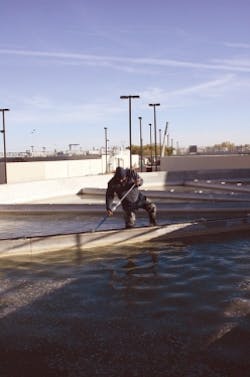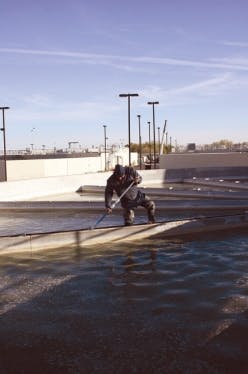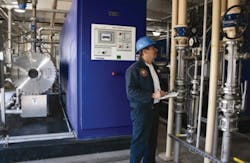Reclaimed Water Plant Helps Quench El Paso's Thirst
The Chihuahua Desert presents a parched landscape that takes in much of Southwest Texas, including El Paso and neighboring Juarez, Mexico. This region is thirsty turf managed by ranches, irrigation districts, an electric power company, and municipal, state and federal agencies. All of these interests want to squeeze more water from the area's limited surface sources and the groundwater held in the underlying permeable sands.
The Rio Grande River, and the area's two major aquifers, had been sapped for decades when El Paso Water Utilities (EPWU) developed a prototype water reclamation plant to help recharge the Hueco Bolson Aquifer, the groundwater source for much of El Paso's potable water. The Fred Hervey Water Reclamation Plant has for decades now been the cornerstone of EPWU's successful efforts for the aquifer storage and retrieval (ASR) program and related reutilization of treated wastewater. In fact, the plant remains one of the most unique facilities in the world and spearheaded EPWU's development of three other water reclamation plants.
Unlike the later facilities whose output flows exclusively to irrigation, the Fred Hervey plant was the nation's first full-scale wastewater reclamation plant to use tertiary treatment to restore wastewater to national and state potable water standards. It remains one of only three such facilities in Texas. More importantly, the 10 mgd -- upgraded soon to12 mgd - plant has operated flawlessly since it went on-line in 1985.
While the aquifer's other users have a vital interest in reliable water supply, the issue of paramount importance for EPWU remains how to provide an adequate supply of affordable drinking water for future generations. It is a challenge confronted by other interests in states upstream along the Rio Grande River and even led to a courtroom border war with New Mexico. Recurring droughts only compound the challenge in this area where the average rainfall is less than nine inches per year.
EPWU has used a 50-year Water Resource Plan, adopted in 1991, as the utility's blueprint to sustain the area's continued growth. The utility, which serves 188,000 water and 179,000 sewer customers, balances conservation, development and acquisition of additional sources, and investment with water reuse infrastructure.
The conservation program has reduced the per capita water use from 200 gallons per day to 133 gallons. While that is certainly notable, EPWU's water reclamation program, embodied in its pioneering ASR program, continues to draw attention from water industry professionals.
Texas-Scale Success
Now decades later, the Fred Hervey Water Reclamation plant continues to serve as the cornerstone of EPWU's water reclamation program. Although the plant's finished water doesn't reach El Paso households directly, the recycled water from this plant continues to extend the life of the Hueco Bolson Aquifer as a groundwater source. The facility also supplements the supply of irrigation water for agricultural operations, golf course irrigation, and cooling water for El Paso Electric's Newman power plant.
The no-discharge plant was designed for continuous production, instead of being demand driven, and consists of companion wastewater and water treatment plants operating in tandem. The treatment trains for the water and wastewater sides consist of screening, degritting, primary clarification, flow equalization, two-stage powdered activated carbon, two-stage re-carbonation, sand filtration, ozonation, granular activated carbon filtration and chlorination before entering storage and distribution. On-line analyzers and lab analyses ensure the quality of the process flow throughout each stage and can divert the flow at any point back to the headworks with any detected problem. The entire train on both sides of the facility is backed up by standby power.
"We typically run 23 analyses daily for contaminants," said Vick Pedregon, plant superintendent. "Beyond those, our permit requires15 different analyses for metals twice a month; analyses for 15 different herbicides and pesticides on a quarterly basis; and another 10 percent of that activity involving other tests done on a monthly or quarterly basis. Conventional plants don't operate in the same manner with all those safeguards."
On the wastewater side, the use of powdered activated carbon treatment to absorb pollutants, ammonia and minute organic contaminants distinguishes the Fred Hervey facility from other wastewater treatment plants. The spent carbon is disposed of and replaced with virgin carbon. High lime treatment raises the pH to kill viruses, mitigate hardness, remove phosphorous and converts heavy metals as hydroxides. The pH is then lowered back down using carbon dioxide and the polished water held a minimum of eight hours in 3.3 MG clear wells where it is thoroughly tested to ensure the quality meets or exceeds standards.
The original 450 lbs/day ozone system was recently replaced and upgraded with a skid-mounted, 650 lbs/day WEDECO EFFIZON® HP ozone system from Xylem. This stage of the treatment remains backed up by chlorine to maintain residual disinfection in distribution lines. Western Summit, now part of Kiewit Corp., performed the upgrade contract that replaced not only the ozone system but the lime slaker and improved the SCADA system. The current and last of four phases involves closing the last of three unlined equalization ponds that hold primary treated wastewater, in addition to creating another powdered active carbon train on the wastewater side. The El Paso office of Brown & Caldwell is serving as the current project engineers.
The high-performance ozone system uses oxygen as feed gas for the two ozone generators. The dual units provide desired redundancy since one, operating alone, can perform the plant's operational requirement. Ancillary equipment includes ozone injection systems (equipped with multiple nozzles), a nitrogen boost system, two ozone destruct units, and a central control panel. A WEDECO spokesman said the system represents a bellwether design in the expected growth in ozone applications at wastewater plants in the wake of many proven applications at potable water plants.
The ozone system is the first form of disinfection in the process train followed by chlorine that provides residual disinfection in the distribution lines. However, the utility has an interest in reducing the amount of chlorine used and the ozone helps in that regard. The ozone system also provides redundancy to the upstream processes that normally provide an excellent reduction.
One area where the ozone system is highly useful is in the conversion of complex compounds that are essentially non-biodegradable to simpler biodegradable forms. This allows removal downstream of the ozone by the biology in the granular carbon filters. Although the utility does not routinely monitor the amount due to the variety and miniscule concentrations of the compounds, university students have at times proven certain benefits. Examples of these compounds would be certain pharmaceuticals that can pass relatively unaffected through conventional treatment processes.
EPWU originally returned the reclaimed water to the aquifer through a field of 10 injection wells drilled to variable depths extending to 800 ft. This was significantly below the 200- to 760-ft. freshwater zone and allowed the reclaimed water to undergo additional natural filtration and gradual blending for approximately two years before reaching the utility's potable wellheads and chlorine disinfection.
The casings of the original injection wells corroded, however, and eventually failed. The utility abandoned them and replaced four with new injection wells of lesser depths. This brought a shift in the ASR program six years ago to using three infiltration ponds developed as a research project with the American Water Works Association. The site for the ponds was selected after a geological study identified strata presenting a 200-ft. layer of underlying sand.
The reclaimed water now trickles down through the sand before reaching the aquifer, essentially the same hydraulic recharge as arroyos during and after a rainstorm. The capacity of the three original infiltration basins was expanded more recently by construction of two more basins. Since water rarely accumulates in the infiltration ponds to any depth, about the only maintenance involves scraping the collected sediment layer off the bottom of each pond on a 9- to 12-month interval.
In 2009, the Fred Hervey plant recycled more than 500 million gallons of reclaimed water back into the aquifer in this manner. This represented nearly one-fifth of the reclaimed water treated to potable quality and was accomplished at an acceptable cost of about $1.82 per thousand gallons.
The treated water has always been below the limits specified by the state in the discharge permit. The quality standards include: Effluent BOD pg -1 mg/L; COD -1 mg/L; TKN less than 1 mg/L; NH 0.2 mg/L; and THM - 0.05 mg/L. For parameters such as chlorides and total dissolved solids, the plant can generally deliver 30 percent below the limit. For others, such as sulfates, nitrates or turbidity, the plant generally operates at nearly 80 percent below the limit. Lead, copper, chromium, mercury, herbicides and other remaining contaminants run below detectable concentrations. The level of automation enables two operators managing the plant on any shift to consistently maintain these quality levels. The plant's entire workforce, in fact, numbers just 30 employees.
More than half of the reclaimed wastewater produced from the Fred Hervey plant now flows to aquifer storage and retrieval (ASR) usage, with 36.6 percent of production sold for power plant cooling water and 12.6 percent to irrigation customers. Power plant use could increase significantly in the future if improved silica removal takes place. This would further extend the life of the aquifer by reducing the amount drawn from the electric utility's wells for cooling water and preserve more of the groundwater for potable use.
Considered innovative from the outset, the award-winning Fred Hervey Water Reclamation Plant remains a model for advanced water recycling facilities. Every year the plant has received the Gold Award from National Association of Clean Water Agencies (NACWA) and is approaching the qualifications to receive a Platinum Award. Since it doesn't discharge, the plant has been ineligible for EPA award recognition. However, the state's recently expanded monitoring responsibilities should make the plant potentially eligible for comparable federal recognition in the future.
Moreover, the volume of reclaimed wastewater continues to increase at EPWU. In conjunction with the Fort Bliss US Army Base, a new joint-venture facility -- the nation's largest inland desalination plant for municipal use - went on line five years ago. The reverse osmosis (RO) membrane plant converts the ever more brackish groundwater into additional potable supply. Although presently running at only 3.5 mgd due to higher operating costs, the Kay Bailey Hutchison desalination plant is rated, with blending, at 27.5 mgd.
Meanwhile, the market for reclaimed water also continues to grow since 1990 when two golf courses became the first non-residential customers, followed by El Paso Electric in 1992. Approved irrigation uses have grown to include schools, parks and cemeteries, as well as the landscaped grounds of apartment complexes, commercial buildings and a tree farm. An emerging lineup of sports fields and other portions of a large regional park complex could potentially require 72 mg per year.
EPWU's success with using leading technologies such as ozone in water reclamation combined with other planning initiatives continues to represent a model in effective water resources management.
WW
More WaterWorld Current Issue Articles
More WaterWorld Archives Issue Articles



